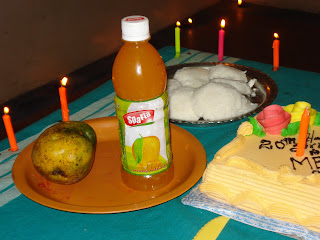
Around 5 am this morning, Valayrmathi and I began our journey to the meeting in Madurai. We packed our bags with churidars and saries, respectively, and walked to the local train station. Like several others I have been on, this train compartment was for "unreserved ticketing", meaning as many people as can squeeze onto the seating bench meant to hold four. Because our tickets were booked at the same time as the village women who were to meet up with us the following morning, my grandma informed us that we were to travel as they would....unreserved! After a four-hour ride from Kuthur to Trichy, and then another three from Trichy to Dindigul (still unreserved), it was time to switch up a little and take a bus. The original plan was to take a rickshaw from the train station to the bus station and then take a bus from there to where we would be staying overnight, but Indian bus tickets are even more unreserved than all trains combined, and for that reason we decided to give in. I gave an auto driver the equivalent of four U.S. dollars and he drove us the whole 30 minutes from the train station to the LAFTI Sarvodaya Workers Home in the town of Gandhigram where we would be staying until the next morning.
Gandhigram is of great significance to me for two particular reasons. One is a bit more obvious, because it is LAFTI's original home, the place where the gigantic flower of their work today initially grew from. Specific to me, however, this is the place where I came to stay with my family for several months in 1998, the place where I remember my grandparents so clearly. I remember waking every morning twelve years ago to find my grandma toiling in the rice patties with all of the other village women, and my grandpa spinning his own shirts and dhotis from 4 am to sunrise. I remember walking to the only nearby shop to purchase a 10-cent square of peanut brittle to make up for all the spicy food I refused to eat, and I remember naming my pet water buffalo Eddie the Edumai (meaning water buffalo in Tamil) and checking in on him every morning before taking him for a short walk. Although Gandhigram was not directly related to our final destination, Madurai, Amma agreed that it was somewhere I should go back and visit along the way as it was only two hours by bus to where we needed to be for the meeting the following morning. To my surprise, I was not the only one who missed Gandhigram and all its originality. Late that evening, the few other female LAFTI staff workers and village women arrived at the Workers Home, as it was the easiest place to find uninterrupted calm and rest when in transit.
So, as the plan continued, we hopped on a bus the following morning in order to make it to the meeting. When we got off at the bus stop, we just began to walk, and walk, and walk. Because the buses were relatively expensive in comparison to the villagers' incomes and because we did not actually know what bus we would need to take to get us to where we were going, it was concluded by the majority of the group that walking was our best possible option if we actually wanted to arrive to the meeting before it ended. So we walked, and walked, and walked.
When we arrived at the meeting on foot, we were one of many. The meeting consisted of several international leaders and their followers discussing various different issues surrounding land and rural development in different area around India. Although the meeting was not being translating from Tamil to English by anyone, I was familiar enough with past speaking events that I had a strong grasp of the general foundation of the topics discussed at this gathering.
Before the second half of the meeting, my grandma suggested that the other villagers and I visit the famous Menakshi temple only a few kilometers away. Home to many beautiful colors, detailed statues, and tall painted elephants, these was plenty with which I could identify, religion and spiritualism aside. It was nearly spiritual for me, however, to see the way in which these village women and others around them so greatly worshipped this ground on which we were walking. While being there was extra special for me as a foreigner, it was even more amazing to be among those who came there regularly, religiously, and spiritually. Being there with these women gave meaning to the bright colors, brought understanding to the stories of the statues, and made a mystical creature out of every elephant standing at a corner.
If you thought spending 12 hours in transit to a five-hour meeting was a bad travel time to destination ratio, you really haven't experienced Indian travel Although I will not mention every detail that contributed to us arriving back to LAFTI around 5 am, I will share one simple example that says it all. When we where waiting to catch the last bus we needed to get back to the headquarters, there was a slight problem. There were three staff members, one intern (me), and 10 village women, all trying to get on a bus. The problem was that according to everyone else in the group, we all needed to get on the same bus and all needed to have our own seat. While this may sound like a simple task when traveling on a bus in the United States, finding a bus with 14 open seats is virtually impossible. While part of my negative attitude at that time may have been due to the 20 mosquito bites I incurred every time a full bus passed by and the fact that I am an American who had been traveling like an Indian for the past 24 hours, this highly frustrating experience turned out to be a truly transformational time for me. After waiting nearly two hours, using every last bit of mosquito repellent available, I finally began to understand. This experience, that frustration, and my immediate judgment of our group's overall inefficiency could all be summarized as just a different way of life. Because no one really had anywhere to be except for possibly back at their homes sleeping, we would all stay together, and that was just a given. I had agreed to travel with the villagers and that is just how they travel. Because few of these women often get a chance to travel to different parts of the country, this 24 hours spent on a bus, a train, or just roaming the streets looking for the location of our meeting was a time for community. This was a time for all 10 villagers to "catch up" to discuss the meeting outcomes, to reflect on the beauty of the temple, and just to be. So as I have been told time and time again when taking part in exchange programs, language classes, or academic studies of the way people live in other parts of the world, "it's not good, it's not bad, it's just different!".













